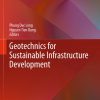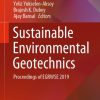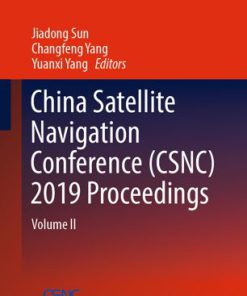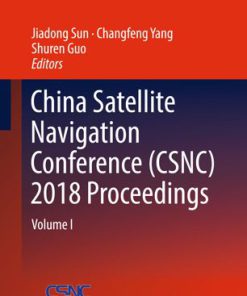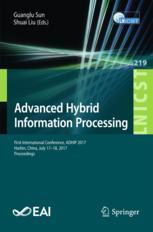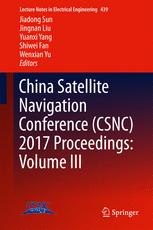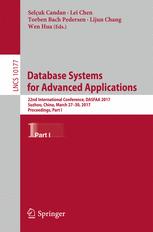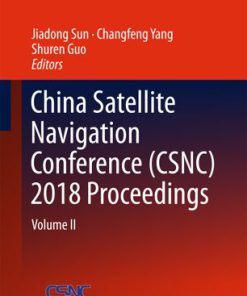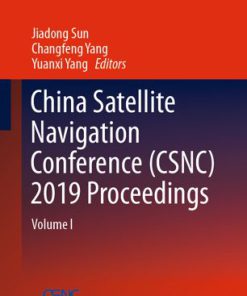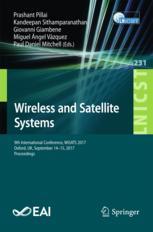China Satellite Navigation Conference CSNC 2017 Proceedings Volume I 1st Edition by Jiadong Sun 9811045882 9789811045882
$50.00 Original price was: $50.00.$25.00Current price is: $25.00.
China Satellite Navigation Conference CSNC 2017 Proceedings Volume I 1st Edition by Jiadong Sun – Ebook PDF Instant Download/DeliveryISBN: 9811045882, 9789811045882
Full download China Satellite Navigation Conference CSNC 2017 Proceedings Volume I 1st Edition after payment.
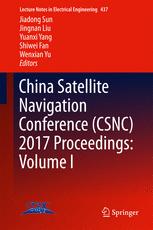
Product details:
ISBN-10 : 9811045882
ISBN-13 : 9789811045882
Author: Jiadong Sun
These proceedings present selected research papers from CSNC2017, held during 23th-25th May in Shanghai, China. The theme of CSNC2017 is Positioning, Connecting All. These papers discuss the technologies and applications of the Global Navigation Satellite System (GNSS), and the latest progress made in the China BeiDou System (BDS) especially. They are divided into 12 topics to match the corresponding sessions in CSNC2017, which broadly covered key topics in GNSS. Readers can learn about the BDS and keep abreast of the latest advances in GNSS techniques and applications.
China Satellite Navigation Conference CSNC 2017 Proceedings Volume I 1st table of contents:
1 Theoretical Study for Bare Soil Freeze/Thaw Process Detection Using GNSS-R/MR
Abstract
1 Introduction
2 Theoretical Models
2.1 Dielectric Permittivity Models
2.2 Surface Reflectivity Models
2.3 The Forward GPS Multipath Model
2.4 The Fully Polarimetric Delay Doppler Map for Freeze/Thaw Soil
3 Theoretical Simulations
3.1 Permittivity for Frozen and Thawn Soil
3.2 Surface Reflectivity Simulations
3.3 Delay Doppler Map Difference
4 Conclusions
Acknowledgements
References
2 The Application of BDS/GPS/GLONASS Data Fusion in FAST Measurement
Abstract
1 Introduction
2 The RTK Measurement of FAST Feed Support Coarse-Adjusting System
2.1 Technical Specifications and Requirements
2.2 RTK Measurement
2.3 Position and Attitude Solution
3 The Importance of BDS/GPS/GLONASS Data Fusion
4 Analysis of RTK Measurement Accuracy
5 Summary and Conclusions
Acknowledgements
References
3 Research on BDS/GPS Combined Single-Epoch Attitude Determination Performance
Abstract
1 Instruction
2 Mathematic Model of BDS/GPS Combined Single-Epoch Attitude Determination
2.1 Unification of BDS/GPS Combined Space-Time Reference
2.2 Construction of BDS/GPS Combined Observation Equation
2.3 Calculation of BDS/GPS Combined Attitude Parameter
3 Experiment and Analysis
3.1 Static Experiment
3.2 Dynamic Experiment
4 Conclusions
References
4 Calculating High Frequency Earth Rotation Parameters Using GPS Observations and Precision Analysis
Abstract
1 Introduction
2 The Principle of GPS Calculation ERP
3 Data Processing and Analysis
3.1 Choose Most Appropriate Station Numbers
3.2 Estimate ERP with a Frequency of 24 h
3.3 Estimate ERP with a Frequency of 2 h
4 Conclusion
References
5 A Comparative Analysis of Relative Positioning Methods for BDS/GPS in Three Different Fields of Co
Abstract
1 Introduction
2 BDS/GPS Combined Relative Positioning Function Model
2.1 GNSS Relative Positioning Function Model
2.2 BDS/GPS Combined in Coordinate Estimates Field Relative Positioning Function Model
2.3 BDS/GPS Combined in Normal Equation Field Relative Positioning Function Model
2.4 BDS/GPS Combined in Observation Equation Field Relative Positioning Function Model
3 Analysis of BDS/GPS Combined in Different Fields Relative Positioning
3.1 Analysis of Single Epoch Solving
3.2 Analysis of Static Sequential Least Squares Solving
3.3 Analysis of Dynamic Sequential Least Squares Solving
4 Exemplification
4.1 Single Epoch Solving
4.1.1 Static Sequential Least Squares Solving
4.2 Analysis of Dynamic Sequential Least Squares Solving
5 Conclusion
Acknowledgements
References
6 Deformation Monitoring and Precision Analysis Based on BDS/GPS Dual System Combination
Abstract
1 Introduction
1.1 BDS and GPS Space and Time Datum Unification
1.1.1 Space Datum Unification
1.1.2 Time Datum Unification
1.1.3 Differences in Satellite Broadcasting Position Calculation
1.2 Combined Positioning Model and Smoothing Filtering
1.2.1 Relative Positioning Model of Dual System Combination
1.2.2 Smoothing Filter for Deformation Monitoring Sequence
1.3 Data Processing and Results Analysis
1.3.1 Data Quality Analysis
1.3.2 Positioning Accuracy Analysis
1.3.3 Smoothing Filter for Monitoring Sequence
1.3.4 Analysis of Station Drift Velocity
1.4 Conclusions
Acknowledgements
References
7 The Research on Nonlinear Attitude Determination Method of GNSS Multi-antenna Attitude Measurement
Abstract
1 Introduction
2 Direct Solution
3 Nonlinear Least Squares Method
3.1 Least Squares Based on Additive Euler Angle Error
3.2 Least Squares Based on Additive Quaternion Error
3.3 Least Squares Based on Multiplicative Euler Angle Error
3.4 Least Squares Based on Multiplicative Quaternion e Error
4 Experiment and Analysis
5 Conclusions
Acknowledgements
References
8 Estimation and Evaluation of the Precipitable Water Vapor from GNSS PPP in Asia Region
Abstract
1 Introduction
2 Estimation of ZWD and PWV
3 Experiment and Analysis
3.1 Experimental Data and Processing Strategies
3.2 ZWD Comparisons Between PPP and GGOS
3.3 Validations with Radiosondes
4 Conclusions
Acknowledgements
References
9 Correlation Analysis Among GPS-SNR, Precipitation and GPS-PWV
Abstract
1 Introduction
2 Technical Methods
2.1 Inversion Principle of Foundation GPS-PWV
2.2 Power Spectrum Analysis Based on GPS-SNR Observations
3 Data Processing and Analysis
3.1 Relationship Between Precipitation and GPS-PWV
3.2 Changes Research of Precipitation and GPS-SNR
3.3 Study on the Changes of GPS-PWV, Precipitation and GPS-SNR
4 Conclusions
Acknowledgements
References
10 The Determination of Plumb-Line Deviation by Adopting GNSS/ Leveling Method in Super Long Tunnel
Abstract
1 Introduction
2 The Calculation Method of Plumb-Line Deviation
2.1 GNSS/Leveling Method
2.2 Earth Gravity Model Method
3 Influence of the Plumb-Line Deviation on BE
3.1 Influence of the Plumb-Line Deviation at the Two Entrances of the Tunnel
3.2 Influence of the Plumb-Line Deviation in the Inclined Shaft
3.3 The Total Influence Value of Plumb-Line Deviation on BE
4 Example and Analyses
4.1 Project Overview
4.1.1 Calculation Result
5 Conclusions and Discussion
Acknowledgements
References
11 BDS/GPS High Precision Railway Deformation Monitoring Software Design and Verification
Abstract
1 Introduction
2 Data Processing Algorithms
2.1 Unity of Time and Coordinate Reference Frame
2.2 Data Processing Strategy
2.3 Data Processing Flow
3 Railway Subsidence Simulation Experiment and Analysis
3.1 Experimental Design
3.2 Time Sequence of Coordinate Difference of Displacement Platform
3.3 Monitoring Accuracy Analysis
4 Conclusions
References
12 Application Performance Analysis of Three GNSS Precise Positioning Technology in Landslide Monito
Abstract
1 Introduction
2 Mathematical Model
3 Exemplification
3.1 Accuracy Test of PPP Solution in Landslide Monitoring
3.2 The Accuracy Test of RTK Solution in Landslide Monitoring
3.3 The Accuracy Test of Baseline Positioning Technology in Landslide Monitoring
3.4 Experimental Test of Slow Change Mode Based on PPP and RTK Positioning Technology
4 Conclusions
Acknowledgements
References
13 GPS Signal to Noise Ratio Analysis and Using for Real-Time Tide Monitoring
Abstract
1 Introduction
2 Characteristic Analysis of GPS SNR
3 The Principle of GPS SNR for Tidal Level Monitoring
4 Application of SNR in Tide Level Monitoring
4.1 Selection of GPS Effective Satellites
4.2 GPS-MR Experimental Data Processing
4.3 Analysis of GPS-MR Experiment Results
5 Conclusion
Acknowledgements
References
14 Ship Detection and Data Processing by Using Shore-Based GNSS-R
Abstract
1 Introduction
2 Analysis of Electromagnetic Scattering
2.1 Analysis of the Mirror Image Component Scattering
2.2 Analysis of Diffuse Scattering Component
2.3 Two-Scale Scattering Model
3 Analysis of the Reflected Signal Characteristic
3.1 Reflection Coefficient
3.2 Analysis of the Scattering Signal Power
4 Data Processing
4.1 Experimental Scene
4.2 Data Processing
5 Conclusion
References
15 Characteristic of GPS SNR and It’s Application for Snow Depth Monitoring Analysis
Abstract
1 Introduction
2 Theory and Methods
2.1 Characteristics Analysis of SNR
2.2 Algorithm and Theory
2.3 SNR Analysis of L1C/A and L2P
3 Analysis of Examples
4 Conclusion
Acknowledgements
References
16 A Fast Algorithm of GNSS-R Signal Processing Based on DBZP
Abstract
1 Introduction
2 Traditional GNSS-R Signal Processing Algorithm
2.1 GNSS-R Signal Model
2.2 Parallel Code Phase Coherent Integration Method
3 A Fast Algorithm of GNSS-R Signal Processing Based on DBZP
3.1 Description of the Algorithm
3.2 Computational Burden Analysis
3.3 Computational Loss Analysis
4 Simulation and Verification
4.1 Simulation Parameters
4.2 Simulation Results
4.2.1 Time-Consuming
4.2.2 Computational Loss
5 Conclusion
References
17 Model Establishment and Analysis of Weighted Mean Temperature in the Region of Guilin
Abstract
1 Introduction
2 Affiliating Scale Average Temperature
3 Existing Local Tm Model
4 Establishment and Comparative Analysis of the Weighted Mean Temperature Model in Guilin Area
5 Conclusion
Acknowledgements
References
18 GNSS-R Ocean Altitude Detection Technology Based on Carrier Phase Assistant
Abstract
1 Introduction
2 Principles of GNSS-R Ocean Detection Technology
2.1 Inversion of Sea Surface Height
2.2 Inverse Principle of GNSS—R Sea Level Based on Carrier Phase
3 Experimental Verification
3.1 Floor-Based Test Validation
3.2 Flight Test Validation
4 Summary
References
19 Characteristics of Coordinate Time Series of Shenzhen Continuously Operating Reference Stations
Abstract
1 Introduction
2 Coordinate Calculation
3 Principal Component Analysis
4 Surface Mass Load Correction
5 Determination of the Optimal Noise Model
6 Analysis of Velocity and Its Uncertainty
7 Conclusions
Acknowledgements
References
20 Voxel Nodes Model Parameterization for GPS Water Vapor Tomography
Abstract
1 Introduction
2 Voxel Nodes Model Parameterization for GPS Tomography
3 GPS Tomography Results
3.1 Tomography Strategy
3.2 Analysis of Total Statistics
4 Conclusion and Outlook
References
21 The Spatial Deformation Characteristic Analysis of CORS Stations: A Case Study of Tianjin CORS
Abstract
1 Background
2 The Models and Methods for the CORS Spatial Deformation Characteristic Analysis
2.1 General Methodology
2.2 The Filtering for the CORS Time Serials Analysis
2.3 The Trend and Detail Analysis of CORS Stations
3 Tianjin CORS Case Study
3.1 The Reference Point Affirmation for Tianjin CORS Deformation Analysis
3.2 Time Serials Denoising and Fitting Analysis
3.3 The Spatial Deformation Characteristic Results
4 Conclusion
Acknowledgements
References
22 Wide Area Beidou Foundation Enhanced Grid Space-Time Interlinked Science and Education Collaborat
Abstract
1 Introduction
2 Wide-Area Beidou Reinforcement Grid-Based Space-Time Collaborative Experiment Service
2.1 Service Platform Design Principles
2.2 Service Platform Design
2.3 Platform of Science and Education Cooperative Experiment Construction
3 Key Technologies
3.1 Virtual Grid Pseudo-range Differential Localization Strategy
3.2 Low-Cost Integrated Navigation Terminal Board
3.3 High Concurrency, Large Data Storage, Processing and Application Access
4 Wide Domain Beidou Enhanced Grid-Based Space-Time Science and Technology Co-experimental Service A
4.1 Teaching Experiment: Internet of Things
4.2 Scientific Research Experiment: Study on Public Traffic Signal Priority
5 Conclusion
Acknowledgements
References
23 Single-Antenna Attitude Determination Using GNSS for Low-Dynamic Carrier
Abstract
1 Introduction
2 Single-Antenna Attitude Determination for Low-Dynamic Carriers
2.1 Pseudo-attitude Determination Method
2.2 Deviations from the Pseudo-attitude Angles to the Real Attitude Angles
2.2.1 Measurement Error
2.2.2 Offset Error
2.2.3 Lateral Error
2.3 Single-Antenna Attitude Determination for Low-Dynamic Carriers
3 Experiments
4 Conclusions
Acknowledgements
References
24 Differenced Measurements Between Satellites Applied on RTK PPP for Structure Monitoring
Abstract
1 Introduction
2 Methodology
2.1 Linear Combined Ionosphere-Free Equation
2.2 Kalman Filter for the Satellite Difference RTK PPP
3 Experiment–Severn Suspension Bridge, UK
4 Results
5 Conclusion
Acknowledgements
References
25 Research on Retrieval of PWV Based on PPP and NCEP/NCAR Global Reanalysis 1 Data
Abstract
1 Introduction
2 Meteorological Data Interpolation Method
2.1 Requirement of Meteorological Data in the Retrieval of PWV
2.2 Method of Meteorology Data Interpolation
2.2.1 Surface Interpolation Method (SIM)
2.2.2 Layer Interpolation Method (LIM)
3 PPP PWV Estimation and Analysis of the Results
3.1 Selected GPS Stations
3.2 Accuracy Evaluation of Interpolated Meteorological Data
3.3 Accuracy Evaluation of PPP PWV
4 Conclusions and Suggestions
Acknowledgements
References
26 Determining the Reasonable Time Resolution of the Precise Satellite Clock Bias Products
Abstract
1 Introduction
2 Analytical Method for Precise Clock Bias Time Series
2.1 Interval Fitting
2.2 Lomb–Scargle Spectrum Analysis
2.3 Non-negative Matrix Factorization Algorithm
3 Determining the Time Resolution of the Precise Clock Bias
3.1 Probability Statistics for the Epoch-Differenced Clock Bias
3.2 Analyzing the Interval Fitting Errors of the Clock Bias
3.3 Spectrum Analysis of the Clock Bias
3.4 Non-negative Matrix Factorization of the Clock Bias
4 Conclusions
Acknowledgements
References
Navigation and Location Service
27 Pseudolite Cellular Network in Urban and Its High Precision Positioning Technology
Abstract
1 Introduction
2 GNSS Pseudolites Positioning Network in Urban
2.1 Composition of Pseudolites Positioning Network
2.2 Compatible Signal of Pseudolites Network
3 Time Synchronization Based on Signal Propagation
4 The Optimal Network Topology and Geometry Factor
4.1 Network Topology of Pseudolites
4.2 Geometric Precision Dilution of Optimal Network Topology
4.3 High Precision Positioning of Pseudolite Cellular Networks
5 Positioning Accuracy Testing of Pseudolite Cellular Network
5.1 Positioning Accuracy Testbed of Pseudolites
5.2 Positioning Result of Pseudolites Cellular Networks
6 Conclusion
References
28 Performance Analysis for AP Selection Strategy
Abstract
1 Introduction
2 AP Selection Strategies
2.1 AP Selection Based on the JIG Maximization
2.2 AP Selection Based on the MI Minimization
2.3 AP Selection Based on the MM
2.4 Performance Evaluation Index
3 Experiments and Analysis
3.1 Analysis on Number of RSS Observations
3.2 Analysis on Number of Subset of Optimal APs
3.3 Effect of Difference AP Selection Strategies
4 Conclusions
Acknowledgements
References
29 Definition of Conversion and Allocation Model for GNSS Index Basing Navigation Performances
Abstract
1 Introduction
2 Conversion and Distribution Model of Navigation Performances Index
2.1 Conversion Model of Positioning Accuracy Index
2.2 Conversion Model of Integrity Index
2.3 Conversion Model of Continuity Index
2.4 Conversion Model of Usability Index
3 Calculation Example Analysis of Navigation Performance Index Conversion
4 Conclusion and Application
References
30 Analysis of GPS for Monitoring Rain and Snow Weather
Abstract
1 Introduction
2 Theory System of GPS for Rain and Snow Weather Monitoring
2.1 Principle of GPS/PWV Detection
2.2 Principle of GPS-MR Technology
3 Analysis of Examples
3.1 Data Source
3.2 Sample Results
4 Conclusion
Acknowledgements
References
31 Evolutionary Particle Filter for Indoor Navigation and Location
Abstract
1 Introduction
2 Extended Kalman Filter
3 Particle Filter
4 A Direction Error Elimination Algorithm Based on Map Information
5 Experimental Results
5.1 Particle Weight Experiment
5.2 Walking Experiment
6 Conclusion
References
32 An Indoor Three Dimensional Positioning Algorithm Based on Attitude Identification and Visible Li
Abstract
1 Introduction
2 Related Work
3 Three Dimensional Positioning Algorithm
3.1 Symbol Description
3.2 Position Model
3.3 Achieving the Normal Vector of Photosurface of Receiver
3.4 Distinguishing Different LED Lamp by FFT
4 Simulation Experiment and Performance Analysis
4.1 Simulation Environment
4.2 Location Performance
4.2.1 Positioning Performance Under Multiple LED Single Observation
4.2.2 Positioning Performance Under Single LED Condition
4.2.3 Positioning Performance Under Multiple LEDs and Multiple Rotation
4.2.4 Complexity
5 Conclusion
Acknowledgements
References
33 An Indoor Positioning and Navigation Technique Based on Wi-Fi Fingerprint and Environment Informa
Abstract
1 Introduction
2 Methodology
2.1 Radio Path Loss Mode
2.2 Fingerprint Technique
2.3 K Nearest Neighbor Algorithm
2.4 Particle Filter (PF)
2.4.1 System Model
2.4.2 Measurement Update
2.5 Dijkstra Algorithm
3 Experiment and Analysis
4 Summary and Discussion
Acknowledgements
References
34 Identification of LBS Deception for Smart Phone Based on the Speed Consistency
Abstract
1 Introduction
2 The State-of-Art, Countermeasures and Challenges of LBS Deception of Smart Phone
2.1 The State-of-Art and the Countermeasures of LBS Deception
2.2 Challenges
3 LBS Deception Identification Based on the Velocity Peak Interval Distribution and the K-S Test
4 Experimental Verification
4.1 Identification Without LBS Deception
4.2 Identification with LBS Deception
5 Conclusion
References
35 iBeacon/WiFi Signal Characteristics Analysis for Indoor Positioning Using Mobile Phone
Abstract
1 Introduction
2 Fingerprint-Based Positioning Principle
2.1 Propagation Model
2.2 Probabilistic Method for Positioning
3 RSS Noise Characteristics of iBeacon and WiFi Signals
3.1 Sampling Rate
3.2 RSS Tendency and Deviation
4 Positioning Performance Evaluation
5 Conclusions
Acknowledgements
References
36 Research on Signal Design Method of Pseudolite “Near-Far Effect” Based on TDMA Technique
Abstract
1 Introduction
2 Overview of the Near-Far Effect
3 Signal Structure Design Based on TDMA
4 Simulation Analysis
4.1 Acquisition Method
4.2 Tracking Method
4.3 Simulation Parameters
4.4 Acquisition Simulation Examples
4.5 Tracking Simulation Examples
5 Conclusion
References
37 Precision Analysis of CNAV Broadcast Ephemeris and Its Impact on the User Positioning
Abstract
1 Introduction
2 Analysis Strategy of CNAV Broadcast Ephemeris Error
2.1 CNAV Parameters
2.2 Algorithm of Satellite Orbits and Clocks Calculation
2.3 Evaluation Methods
3 Analysis of CNAV Broadcast Ephemeris Error
3.1 Analysis Precision of Orbit Errors
3.2 Analysis Precision of Clock Bias
3.3 SISRE Analysis
4 Performance of CNAV Broadcast Ephemeris on User Positioning
5 Conclusions
Acknowledgements
References
38 Research on Path Loss and Multipath Propagation of Indoor Pseudolite Signal
Abstract
1 The Introduction
2 Analysis of Indoor Pseudolite Signal Propagation Effect
2.1 Indoor Pseudolite Signal Propagation Characteristics
2.2 Indoor Pseudolite Channel Modelling
3 Simulation Analysis of Indoor Pseudolite Signal Propagation Effects
3.1 Pseudolite Signal Propagation Simulation of the General Environment
3.2 Pseudolite Signal Propagation Simulation Barrier Environment
4 Related Experiments and Analysis
4.1 Test on Pseudolite Signal Power Attenuation Model
4.1.1 General Environment Experiment
4.1.2 Obstacle Environment Experiment
4.2 Pseudo Satellite Signal Multipath Transmission Test
5 Conclusion
References
39 The GNSS/Inertial Navigation Based Private Car Incentive Travel Information Platform
Abstract
1 Project Background
2 Project Design
3 Project System Architecture
3.1 Car Terminal
3.2 Data Center
3.3 Management Platform
4 System Working Process
5 System Experimental Data Analysis
5.1 Traffic Comprehensive Index Model
5.2 Construction of Experimental Environment
6 Conclusion
Acknowledgements
References
40 Research on the Next Generation of Emergency Positioning Signal Design and Ground Stations Receiv
Abstract
1 Introduction
2 Main Features and Optimal Design of Emergency Location Signals
3 Ground Receiving Combine Processing Scheme and Performance Evaluation
4 Conclusion
References
41 Obstacle Avoidance Path Planning of Rotor UAV
Abstract
1 Introduction
2 Related Research
2.1 The Principle of Artificial Potential Field Method
2.2 The Principle of Genetic Algorithm
3 Modeling of Path Planning
3.1 Obstacle Avoidance Path Planning Model for Single Obstacle
3.2 Obstacle Avoidance Path Planning Model with Multiple Obstacles
3.3 Real-Time Obstacle Avoidance Path Planning Model
4 Simulation
4.1 Simulation of Obstacle Avoidance Path Planning for Single Obstacle
4.2 Multi Obstacle Avoidance Path Planning Simulation
4.3 Real-Time Obstacle Avoidance Path Planning and Simulation
5 Conclusion
References
42 Orbit Analysis for Tiangong-2 Space Lab Under Different Perturbation Forces
Abstract
1 Introduction
2 Perturbation Force Analysis for Tiangong-2
3 The Sensitive of the Earth Non-spherical Gravity
4 Atmospheric Drag Influence on Tiangong-2
5 Conclusions
Acknowledgements
References
43 Research on Topological Map Building Based on Crowdsourcing Data
Abstract
1 Introduction
2 Topological Map Building System Design
2.1 Topological Map Structure
2.2 Architecture of Topological Map Building System
3 Topological Map Building Algorithm
3.1 Path Data Partition Algorithm
3.2 Road Segment Matching Algorithm
3.3 Splicing, Updating and Coordinate Generation
4 Tests and Analysis
4.1 Road Segment Partition Results
4.2 Road Segment Matching Results
4.3 Topological Map Generation Result
5 Conclusions
References
Test and Assessment Technology
44 High Precision Broadband Direct-Spread Signal Delay Control Based on Phase Controlled Waveform He
Abstract
1 Introduction
2 Principle of Controlling Broadband Signal Delay Directly by NCO Phase
3 Definition of the Finite State of the Baseband Signal Waveform
4 The Implementation of Delay Control Phase Controlled Hermite Waveform Interpolation
4.1 The Implementation Structure
4.2 Analyze of Hardware Resource Consumption
5 Testing Results
6 Conclusions
Acknowledgements
References
45 The Evaluation of Improvement of GPS Performance Combined with Quasi-Zenith Satellite System in J
Abstract
1 Introduction
2 The Overview of Quasi-Zenith Satellite System
3 The Improvement of GPS Aided with QZSS in the Aspect of Constellation Structure
4 The Improvement of GPS Aided with QZSS in the Aspect of Positioning Performance
5 Conclusion
References
46 Study on Test Consistency Which Based on the Record and Playback Instrument
Abstract
1 Introduction
2 Record, Playback and Calibration System
2.1 Record and Playback Instrument
2.2 Dynamic Scene Calibration System
3 Research on Consistency of Playback Test
3.1 Repeatability
3.2 Stability
4 Summary
5 Prospect
References
47 Multipath Effect Analysis of Beidou Satellite Pseudorange and Its Correction
Abstract
1 Introduction
2 Multipath Effect Analysis
2.1 The Relationship Between Multipath Effect and Signal to Noise Ratio
2.2 Relationship Between Multipath Error and Elevation Angle
2.3 Correlation Analysis of Multipath Error and Elevation Angle
3 Polynomial Fitting Method to Correct Multipath Error
3.1 Model Building
3.2 Experiment and Analysis
4 Wavelet Transform to Correct Multipath Error
4.1 Fundamentals
4.2 Experiment and Analysis
5 Conclusion
Acknowledgements
References
48 The Research on Time Series Modeling of ARMA and Medium/Long-Term Forecasting Method Using Global
Abstract
1 Introduction
2 ARMA Modeling and Forecasting
2.1 Modeling Method of ARMA
2.2 The Forecasting Method of ARMA
2.3 The Statistical Methods of Forecasting Results
3 Examples of Analysis
3.1 Modeling and Fitting Statistics
3.2 Statistic Forecasting Results
4 Conclusion
Acknowledgements
References
49 Comparison and Evaluation of Satellite Performance Based on Different Clock Products
Abstract
1 Introduction
2 Performance Evaluation of Satellite Clock
2.1 Frequency Accuracy
2.2 Frequency Drift Rate
2.3 Frequency Stability
3 Data Processing Analysis and Evaluation
3.1 Performance Analysis and Comparison of Different Clock Difference Products
3.1.1 Accuracy Analysis and Comparison
3.1.2 Drift Rate Analysis and Comparison
3.1.3 Stability Analysis and Comparison
3.2 WUM Precise Clock Difference Evaluation of Satellite Clock Performance
3.2.1 Accuracy Assessment
3.2.2 Drift Rate Assessment
3.2.3 Stability Assessment
3.2.4 Performance Analysis of Satellite Atomic Clock
3.2.5 Comprehensive Analysis of GNSS Performance Evaluation
4 Conclusion
Acknowledgements
References
50 Research on Monitoring and Evaluating Method of Beidou Monitoring Receiver Inter-frequency Bias
Abstract
1 Introduction
2 Mathematical Models
3 Data Processing
4 Conclusions and Discussion
References
51 BDS Multipath Real-Time Estimation Based on Generalized Regression Neural Network
Abstract
1 Introduction
2 Mathematical Model
2.1 The Measurement of Multipath
2.2 Generalized Regression Neural Network Model
3 Experiments and Results Analysis
3.1 BDS Multipath Characteristics Analysis
3.2 Analyze the Influence of Code Variations on Multipath
3.3 Multipath Real Time Estimation Based on GRNN
4 Conclusion
Acknowledgements
References
52 Ephemeris Type B Fault Detection for BDS
Abstract
1 Introduction
2 Protection Levels and Minimum Detectable Error
3 YE-TE Is not Suitable for BDS
4 Detection of BDS Ephemeris Type B Fault
5 Experimental Verification
6 Conclusions
References
People also search for China Satellite Navigation Conference CSNC 2017 Proceedings Volume I 1st:
does china have gps satellites
china satellite news
china satellite constellation
china satellite launch latest news
china satellite communications
Tags: China Satellite, Navigation, Conference, Jiadong Sun
You may also like…
Engineering - Telecommunications
China Satellite Navigation Conference CSNC 2019 Proceedings Volume II Jiadong Sun
Engineering - Environmental
China Satellite Navigation Conference CSNC 2018 Proceedings Volume III Jiadong Sun
Engineering - Environmental
China Satellite Navigation Conference CSNC 2017 Proceedings Volume III 1st Edition Jiadong Sun
Engineering - Environmental
China Satellite Navigation Conference CSNC 2018 Proceedings Volume II Jiadong Sun
Engineering - Telecommunications
Computers - Computer Science


